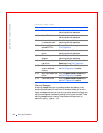
Solving Problems 201
Typically, your operating system's start-up files (such as config.sys and
autoexec.bat) contain commands to start TSR programs when you boot
your computer. If you suspect that one of these TSR programs is causing a
memory conflict, remove the commands that start them from the start-up
files. If the problem you were experiencing does not recur, one of the TSR
programs probably created the conflict. Add the TSR commands back into
the start-up files one at a time until you identify which TSR program is
creating the conflict.
Program Conflicts
Some programs may leave portions of their setup information behind, even
though you have exited from them. As a result, other programs cannot run.
Rebooting your computer can confirm whether or not these programs are
the cause of the problem.
Memory Address Conflicts
Memory address conflicts occur when two or more devices try to access the
same address in the upper memory blocks (UMB). For example, if a network
expansion card and an expanded-memory page frame are assigned an
overlapping block of addresses, a memory address conflict arises. As a result,
when you try to log in to the network, the operation fails.
To resolve this type of conflict, you can change the address of one of the
devices. For example, in the case of the network expansion card and
expanded-memory page frame address conflict, you can move the network
card to an address block in the range of CC000h through D0000h. To
reassign the expansion card's address block, refer to the documentation for
the card.
Interrupt Assignment Conflicts
Problems can arise if two devices attempt to use the same interrupt request
(IRQ) line. To avoid this type of conflict, check the documentation for the
default IRQ-line setting for each installed expansion card. Then consult the
following table to configure the card for one of the available IRQ lines.


















